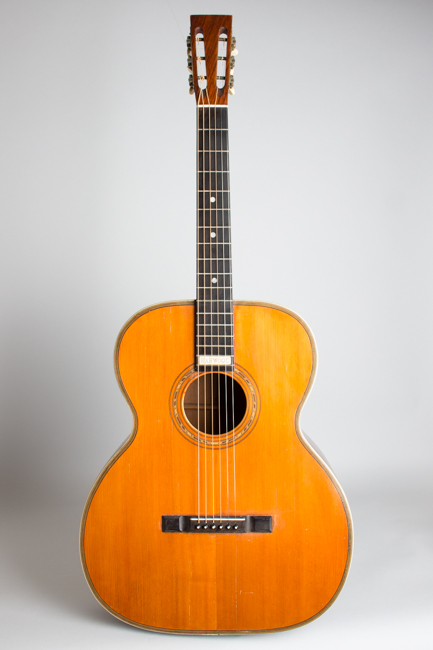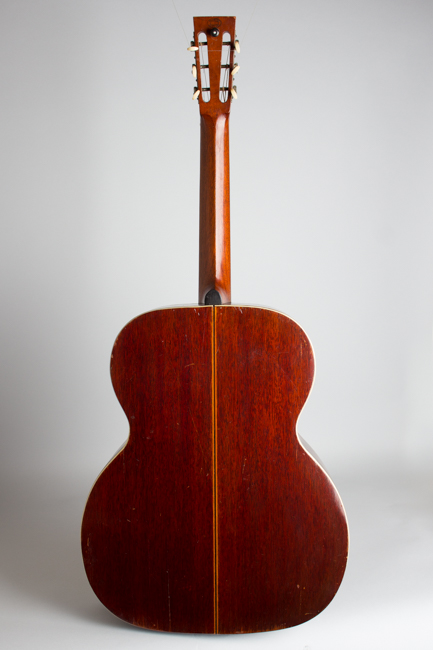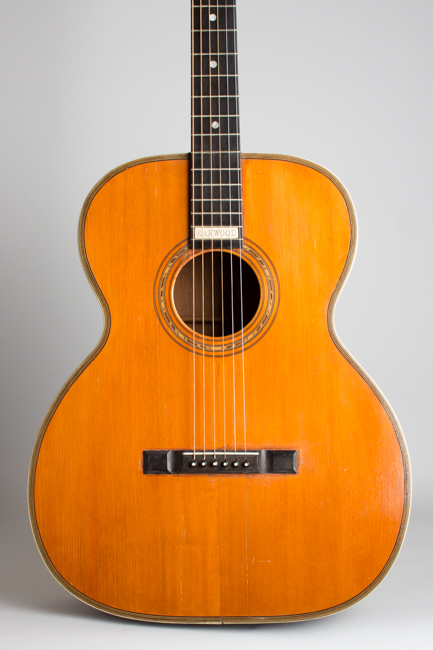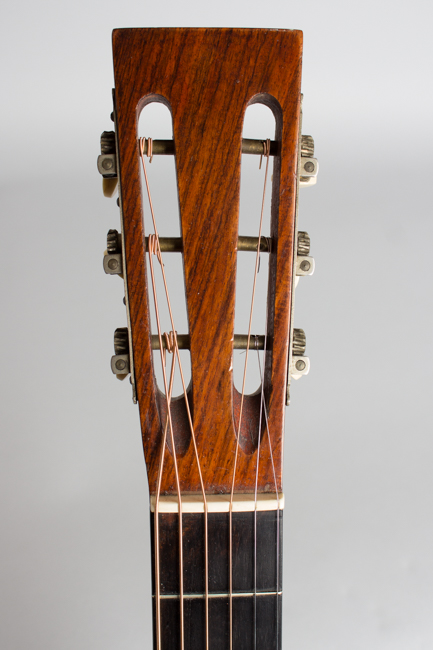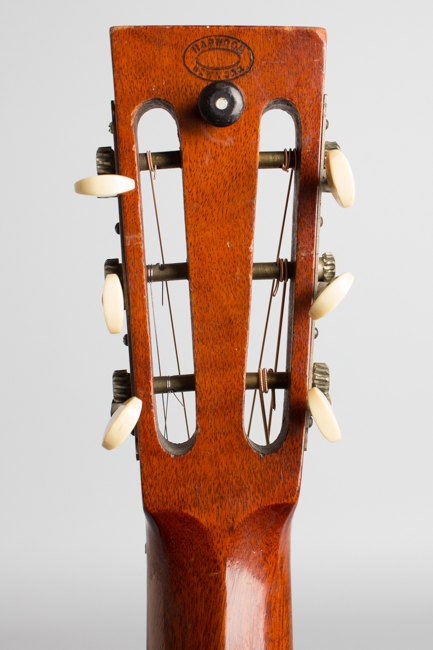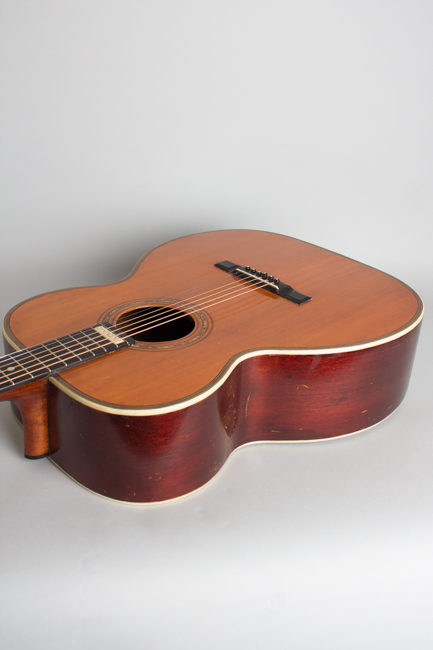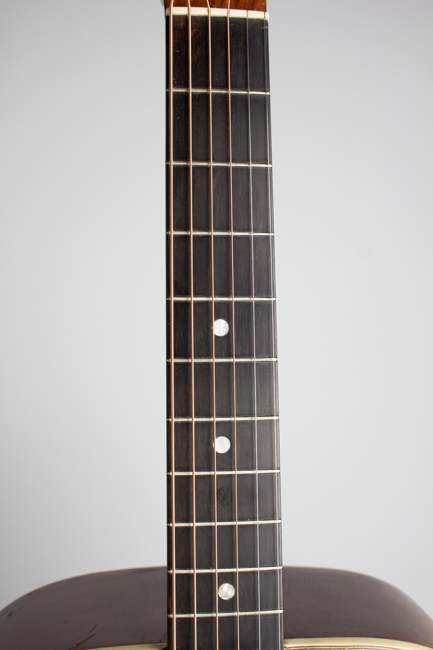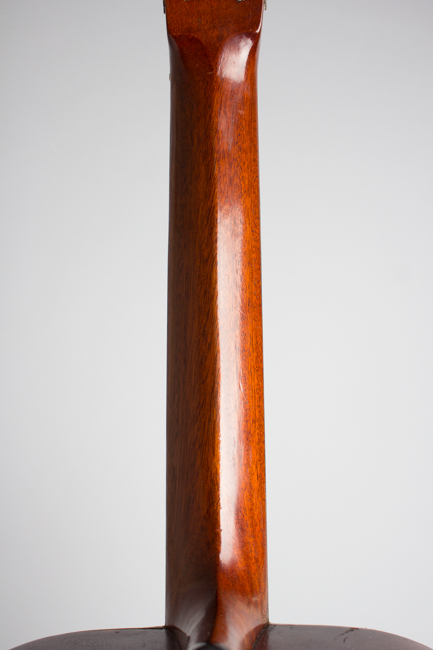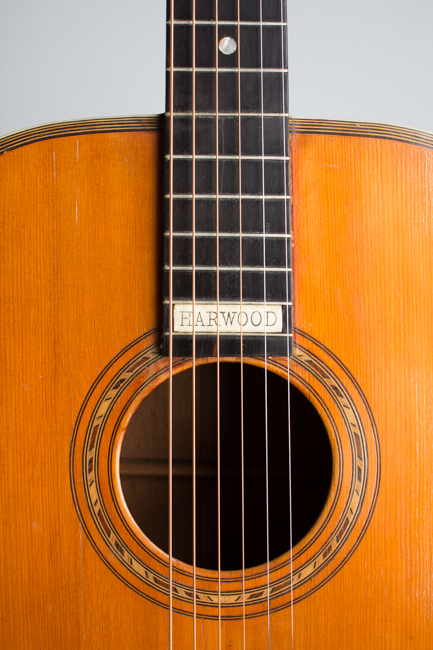Harwood Auditorium Special 1018 Flat Top Acoustic Guitar , c. 1915
This item has been sold.
Item # 4497
Prices subject to change without notice.
Harwood Auditorium Special 1018 Model Flat Top Acoustic Guitar, c. 1915, made in Kansas City, serial # 26613, natural varnish finish, mahogany back, sides and neck; spruce top, ebony fingerboard, soft shell case.
"Harwood" is one of those mystery brand names that dot the American musical instrument landscape of the pre-depression age. In late 19th and early 20th centuries it was a trademark used by J.W. Jenkins Sons of Kansas City, one of the west's biggest jobbers, for their best quality instruments. Some guitars-like this one-are marked "Harwood-New York" but no connection to a New York origin has ever become evident. Perhaps folks in the Kansas City area were expected to be impressed by the claim that the instruments came from the Metropolis so far away!
Many details of this guitar are similar to the best Chicago made instruments of the time, but not an exact match for any known maker's stylistic quirks. Jenkins claim to have made the line in-house; recent research supports this and in fact points to a 30 year plus operation of a small factory in Kansas City building fairly high-grade merchandise. While their origin long proved elusive, all Harwood instruments that survive are generally very well made of top quality materials.
This is an extremely large guitar for its period, measuring well over 16" across the lower bout. The body is also quite deep, over 5" at the endpin. The Jenkins catalog description from 1918 states this model "is considerably larger than the regular Auditorium size…one of the grandest guitars ever made". The woods are very high-grade throughout and the workmanship is excellent if a bit inexact, quite similar to many Larson Brothers products. The single-plate tuners are the same fancy Waverly-made keys used by the Larsons, Martin, National and others in the 1910's and '20's. While smaller Harwood models were of rosewood, this very large guitar was built of "selected mahogany".
The very tight-grain spruce top (described as "Norway Spruce") is ladder braced in "the Harwood System" and has survived quite well with only minimal bellying. The neck/body joint is at the 11th fret, which is most unusual in any era. The extremely thick ebony fingerboard carries pearl dots at frets 5,7, and 10 and an engraved bone "Harwood" logo plate inlaid between the last frets. The top is edged with thick celluloid binding and multiple wood purfling, while the soundhole has more traditional wood marquetry and rings.
These large-body guitars from the early 20th century are generally thought to have been intended for use in the mandolin and banjo club orchestras of the period; Jenkins advised "it is made especially for accompaniment work" and noted its "quality of tone…exceptional volume and great ease of playing". This model was the top of the Harwood line and retailed at $50.00 in 1918, including a canvas case ("free of charge") and a 5-year written guarantee. These early large-body guitars have been gaining in interest and collector appreciation recently, as the history of the pre-dreadnought era American guitar saga is more explored.
Jenkins claimed that the Harwood line were the finest guitars built, and while C.F. Martin and Lyon & Healy might have begged to differ this model is a unique and very nicely made guitar. As a playing instrument this guitar has a lovely sound solo or in ensemble context and in both material and construction is one of the finest of this type of jumbo guitar we have seen.
Overall length is 39 1/4 in. (99.7 cm.), 16 1/2 in. (41.9 cm.) wide at lower bout, and 5 1/4 in. (13.3 cm.) in depth at side, taken at the end block. Scale length is 24 3/8 in. (619 mm.). Width of nut is 1 7/8 in. (48 mm.). This guitar shows number of old crack repairs but very good playing condition with a big, resonant sound. It appears all original (bridge has been re-attached but appears correct) and unaltered. One repaired area of punched-in wood by the endpin was rather sloppily handled but is solid. Overall a really good playing example of an extremely rare American guitar-this the only Harwood of this style we have ever seen. Very Good + Condition.
"Harwood" is one of those mystery brand names that dot the American musical instrument landscape of the pre-depression age. In late 19th and early 20th centuries it was a trademark used by J.W. Jenkins Sons of Kansas City, one of the west's biggest jobbers, for their best quality instruments. Some guitars-like this one-are marked "Harwood-New York" but no connection to a New York origin has ever become evident. Perhaps folks in the Kansas City area were expected to be impressed by the claim that the instruments came from the Metropolis so far away!
Many details of this guitar are similar to the best Chicago made instruments of the time, but not an exact match for any known maker's stylistic quirks. Jenkins claim to have made the line in-house; recent research supports this and in fact points to a 30 year plus operation of a small factory in Kansas City building fairly high-grade merchandise. While their origin long proved elusive, all Harwood instruments that survive are generally very well made of top quality materials.
This is an extremely large guitar for its period, measuring well over 16" across the lower bout. The body is also quite deep, over 5" at the endpin. The Jenkins catalog description from 1918 states this model "is considerably larger than the regular Auditorium size…one of the grandest guitars ever made". The woods are very high-grade throughout and the workmanship is excellent if a bit inexact, quite similar to many Larson Brothers products. The single-plate tuners are the same fancy Waverly-made keys used by the Larsons, Martin, National and others in the 1910's and '20's. While smaller Harwood models were of rosewood, this very large guitar was built of "selected mahogany".
The very tight-grain spruce top (described as "Norway Spruce") is ladder braced in "the Harwood System" and has survived quite well with only minimal bellying. The neck/body joint is at the 11th fret, which is most unusual in any era. The extremely thick ebony fingerboard carries pearl dots at frets 5,7, and 10 and an engraved bone "Harwood" logo plate inlaid between the last frets. The top is edged with thick celluloid binding and multiple wood purfling, while the soundhole has more traditional wood marquetry and rings.
These large-body guitars from the early 20th century are generally thought to have been intended for use in the mandolin and banjo club orchestras of the period; Jenkins advised "it is made especially for accompaniment work" and noted its "quality of tone…exceptional volume and great ease of playing". This model was the top of the Harwood line and retailed at $50.00 in 1918, including a canvas case ("free of charge") and a 5-year written guarantee. These early large-body guitars have been gaining in interest and collector appreciation recently, as the history of the pre-dreadnought era American guitar saga is more explored.
Jenkins claimed that the Harwood line were the finest guitars built, and while C.F. Martin and Lyon & Healy might have begged to differ this model is a unique and very nicely made guitar. As a playing instrument this guitar has a lovely sound solo or in ensemble context and in both material and construction is one of the finest of this type of jumbo guitar we have seen.
Overall length is 39 1/4 in. (99.7 cm.), 16 1/2 in. (41.9 cm.) wide at lower bout, and 5 1/4 in. (13.3 cm.) in depth at side, taken at the end block. Scale length is 24 3/8 in. (619 mm.). Width of nut is 1 7/8 in. (48 mm.). This guitar shows number of old crack repairs but very good playing condition with a big, resonant sound. It appears all original (bridge has been re-attached but appears correct) and unaltered. One repaired area of punched-in wood by the endpin was rather sloppily handled but is solid. Overall a really good playing example of an extremely rare American guitar-this the only Harwood of this style we have ever seen. Very Good + Condition.
